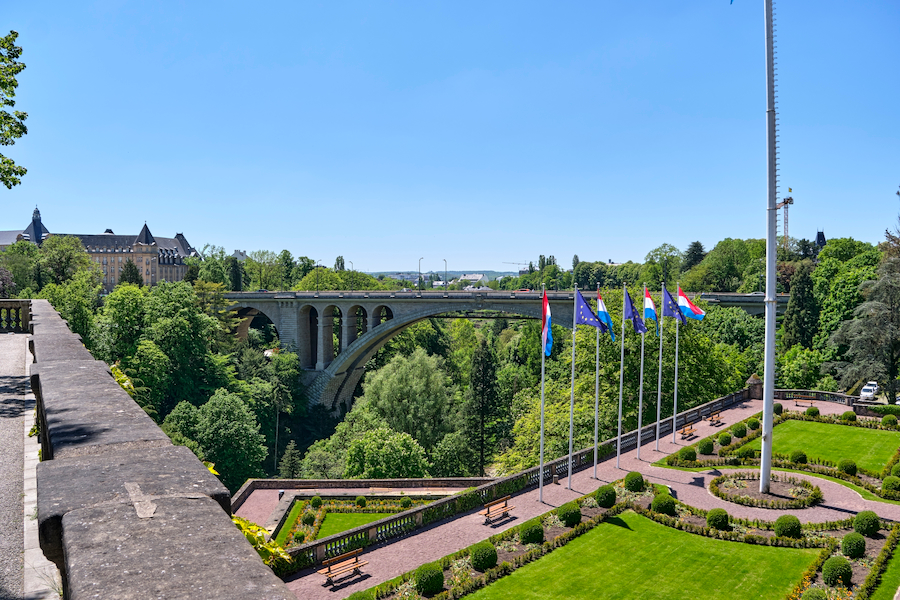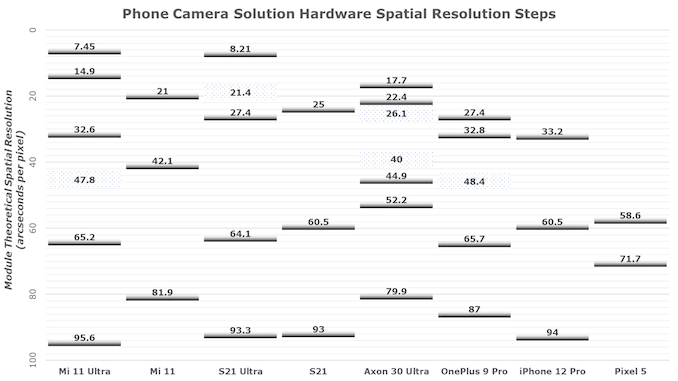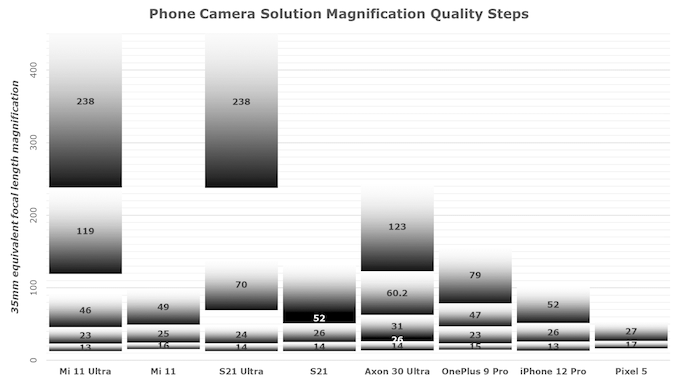Mobile Flagship Phone Cameras 2021 H1 Review: Megapixels & Telephotos
by Andrei Frumusanu on June 21, 2021 9:30 AM ESTDaylight: Intermediate Focal Lengths, Ultra-Wide
Beyond the periscope telephoto phones, at intermediate focal lengths and ultra-wide solutions, there’s a lot more varied hardware solutions amongst all of the devices today. It’s actually a complex topic that we generally never looked at more empirically in terms of what the theoretical camera hardware should actually be capable of, so first I wanted to revisit the metrics of the theoretical spatial resolution of the various camera modules optics and sensor combinations.
Spatial resolution here is determined in arcseconds per pixel: an arcsecond is 1/3600th of a degree in a field of view, so essentially, we’re just determining the amount of the FoV that one pixel takes up. The lower the angle per pixel, the more detailed the resulting picture is in terms of spatial resolution representation of the subject is. Of course, this is dependent on the camera module’s optical frame – i.e. the focal length and the resulting FoV, as well as the sensor’s resolution in terms of pixels.
Because phone cameras don’t actually have true zooming optics – meaning actually moving analog moving optics elements that increase or decrease the focal length, essentially making them prime lenses, it means that the devices only have a certain set of discrete native spatial resolution steps.
What’s interesting about this chart is not only the revealing of the various camera modules’ native spatial resolution, but also the inclusion of the many quad-Bayer camera sensors which essentially have two working resolutions, either the full native small pixel resolution, or the 4:1 or 9:1 (in case of Samsung’s nona-Bayer) pixel binned modes.
Starting off with the Mi 11 Ultra for example, although the camera only has three physical camera modules, the phone actually has six different spatial resolution steps if you actually count the binning and native modes of the various sensors. It’s to be noted, that there’s also native resolution modes that actually don’t make practical sensor in the every-day photography modes of the cameras – for example on the Mi 11 Ultra it’s pointless to use the ultra-wide angle’s 48MP native resolution mode when magnifying in the camera app as the phone will switch over to the main camera module with a superior optical focal length anyhow. The same applies to the OnePlus 9 Pro UWA, and the Axon 30 Ultra also actually doesn’t use its native 64MP sensor capture modes on the UWA or main camera in the normal magnification levels of the camera app, though it uses the secondary wide angle in this mode. Of course, these modes are still available to use when you actually enable the high-res capture modes of the various devices, but I want to focus on the “normal” camera experience in the regular resolution capture mode of the devices first and foremost.
On the S21 Ultra, the 108MP sensor is a bit special because of its 9:1 pixel bin mode, having spatial resolution steps at 64.1 arcseconds per pixel in the default 12MP mode, or 21.4 arcseconds per pixel in the 108MP mode. This latter resolution is also actually never used in the camera’s default operation mode, which like the other phone’s is why it’s marked out in the chart.
Other devices which are notable to mention is the S21’s 64MP secondary wide-angle module which exhibits extremely good spatial resolution even though even though the optical system isn’t technically a telephoto at all, more on this in a bit.
The OnePlus 9 Pro is also curious as the small 8MP telephoto module’s spatial resolution is really only marginally higher than the native capture mode of the main camera.
Devices like the iPhone 12 Pro and Pixel 5 are simple in terms of the hardware here as they’re normal Bayer sensors with 3 or 2-module camera systems.
Ignoring the hardware steps which aren’t being used by the default camera applications, we end up with a chart of the various phones’ “native” camera modules at their resulting effective focal lengths. Native in the sense that at the given focal length, the camera systems are actually able to produce results at the default 12MP capture modes instead of upscaling or cropping the images.
Starting off with the Mi 11 Ultra again as an example – even though the phone only has 3 physical modules, it behaves as if it would have 5 camera modules, because it has 5 different full 12MP quality capture steps. Similarly, the Mi 11 and the OnePlus 9 Pro also take advantage of their main camera sensor’s native resolutions to have a “virtual” mid-telephoto module at 47-49mm which still produces full quality 12MP images (Full quality at least in terms of luminance information, colour information is still limited).
The Galaxy S21 (and S20) are special in this chart – so in general, I depict the gradients starting from their full native resolution and gradually degrading until up to 2x digital magnification. The S21 doesn’t behave like this: in the Samsung camera app, the phone will use the main camera up to 52mm equivalent magnification (2x zoom) where it then switches to the secondary 64MP wide angle. I’m not sure why they do this, they could in theory switch over a bit earlier as the actual module has a 27.6mm optical focal length, maybe they still want to take advantage of the dynamic range of the main sensor’s much larger pixels up to that point. The thing is, at 52mm equivalent focal length magnification, the 12MP default capture mode is still well below the actual spatial resolution capability of the 64MP module, so you can still magnify more in a lossless fashion up until 62.4mm before the camera app switches from downscaling to 12MP to upscaling to 12MP resulting captures.
The Axon 30 Ultra is interesting because of the three quad-Bayer sensors. The ultra-wide and main cameras don’t use their native resolutions in the default capture modes, however the secondary 31mm wide angle will go to 64MP mode in some lighting conditions and at >2.4x magnification, giving you a sort of a 60mm camera, but I found this to be quite inconsistent to wary a lot based on the scene.
The previous chart was on a logarithmic scale for better depictions of the individual steps, but plotting it to an actual linear scale to the focal length showcases the “quality gaps” more evidently. Again, assuming digital upscaling up to 2x is still acceptable, we see various devices not having solutions at some focal lengths beyond that. The Mi 11 Ultra at around 80mm or 4x magnification great, and the S21 Ultra suffers large gaps between 2x-2.9x and 4x-9.9x. Both these phones actually attempt to do image fusion between the different sensors, overlapping parts of the longer focal length module images onto the wider-angle module. This technique is rather prone to weird looking artefacts and extremely inconsistent, especially on the S21 Ultra, or just doesn’t work at all.

[ X-T30 ( ) ( ) ]
[ S21U(S) ] [ S21U(E) ]
[ Mi 11 Ultra ] [ Axon 30 Ultra ]
[ OnePlus 9 Pro ] [ Mi 11 ]
[ S21(E) ] [ iPhone 12 Pro ] [ Pixel 5 ]
We’re following up on some of the scenes from the previous page, this time around focusing on the shorter focal ranges.
On the S21 Ultras, it’s again the Snapdragon which showcases the better image on the ultra-wide as it’s able to maintain more natural detail retention, whereas the Exynos seems to have a detrimental sharpening filter going on. The Exynos S21 also looks near identical, though remember this is a different sensor, although it has the same specifications.
Both Xiaomi phones have a very natural preservation of details with what appears to be no postprocessing of structure or sharpening, which gives the Mi 11 Ultra the most “big sensor” look out of all the phones. What’s not great about it is the outer regions of the frame which suffer from considerable optical aberrations and blurriness.
The OnePlus 9 Pro’s appear to be the most performant, even though it’s not quite as a wide field of view as some of the other devices. There’s a lot of structure processing and sharpening going on here and it gives a very artificial look though. The exposure is lacking in the highlights as it’s one of the most muted results of any device here, which can also be seen in the histogram of the picture.
The Axon 30 Ultra has a great ultra-wide with very good quality details all whilst remaining very natural. The iPhone 12 Pro’s performance looks relatively dated compared to the other phones – exposure is nice but detail preservation is amongst the worst. The Pixel 5 has amongst one of the sharpest ultra-wides which corresponds to the actual spatial resolution mentioned earlier, but that’s partly also because the field of view is narrower for this 16MP sensor.

[ X-T30 ( ) ( ) ]
[ S21U(S) ] [ S21U(E) ]
[ Mi 11 Ultra ] [ Axon 30 Ultra ]
[ OnePlus 9 Pro ] [ Mi 11 ]
[ S21(E) ] [ iPhone 12 Pro ] [ Pixel 5 ]
The next scene is similar in characteristics on the ultra-wides – the Snapdragon S21 Ultra is much better than either Exynos phones through superior detail retention. The other phones also are largely the same in terms of their strengths and weaknesses.
One thing of note is the iPhone 12 Pro picture which is far more natural looking in terms of colours and matching the Fuji reference – it’s the only phone that actually captures in wide colour gamut and thus is able to well represent the sunlit colours of the scene.
Looking at around the 50mm focal length or 2x magnification level, things are a bit interesting and where our prior discussion about sensor spatial resolution comes into play:
In regards to detail, the regular Galaxy S21 is by far the strongest amongst all the devices here. Following closely is the iPhone 12 Pro which has by far the best colours and exposure balance. The Mi 11 Ultra is quite good with the details; however, the exposure appears extremely dark and lacks a lot of dynamic range, a similar thing can be said of the Axon 30 Ultra. The OnePlus 9 Pro’s result, unlike the previous scene, feels like an upscaling of the binned 12MP shot, and has in general flattened and clipped highlights. The Pixel 5 has to digitally zoom in, and the same applies to both S21 Ultras whose 2x shots look no different than a digital crop out of the 1x images.

[ X-T30 ( ) ( ) ]
[ S21U(S) ] [ S21U(E) ]
[ Mi 11 Ultra ] [ Axon 30 Ultra ]
[ OnePlus 9 Pro ] [ Mi 11 ]
[ S21(E) ] [ iPhone 12 Pro ]
On this next very contrast-rich and high dynamic range shot, both S21 Ultras are doing well even though their metering was a bit different, the Snapdragon prioritised maintaining highlight detail whereas the Exynos has better shadows details, with similar results on the S21.
The Mi 11 Ultra has a very natural look in details, but I found the HDR to be too weak in regards to the shadows. The Mi 11 is similar in that the HDR isn’t very strong in returning textures both in highlights or shadows.
The OnePlus 9 Pro has good detail retention for the highlights but goes a tad too far compared to what it should be doing, resulting in bad shadows, that roof of the bell tower is literally reflecting the sun and not even my Fuji could maintain highlights there, yet the OP9Pro isn’t even clipping to full white here.
The iPhone 12 Pro has impeccable tone curves and HDR, and it’s surprising how well it does given the smaller sensor.
The Axon 30 Ultra did a fantastic job and actually is the device with the by far best HDR result in this scene, maintaining good highlights and shadow details simultaneously, all while having good textures without any over-sharpening. Just the colour temperature was off as being too warm.
At 50mm/2x the pecking order is the S21 leading by considerable amounts again, followed by the Mi 11 Ultra, iPhone 12 Pro, OnePlus 9 Pro, Axon 30 Ultra, Mi 11, and finally the S21 Ultras as last. The one change here from the previous scene is that the OP9Pro here used its native resolution instead of binning. Unfortunately I forgot to take samples with the Pixel 5 here.

[ X-T30 ( ) ]
[ S21U(S) ] [ S21U(E) ]
[ Mi 11 Ultra ] [ Axon 30 Ultra ]
[ OnePlus 9 Pro ] [ Mi 11 ]
[ S21(E) ] [ iPhone 12 Pro ] [ Pixel 5 ]
This is another difficult scene, with extremely bright highlights, but most of the scene dominate by shadows.
The Samsung phones are again all over the place, the Snapdragon S21 Ultra just vastly superior in HDR and natural detail retention compared to the Exynos. The Exynos S21 Ultra is also beat by the smaller S21 both at 1x and 2x,
Almost all phones had trouble with exposure and HDR, the Pixel 5 had by far the best result and natural looking representation, followed by the Xiaomi phones, with the Mi 11 Ultra having great details. The iPhone’s exposure it taken way too far and also misses badly on colour temperature.
The OnePlus 9 Pro is plagued by the company’s utterly unrealistic handling of blacks and dark shadows, rendering the tree trunk barks clipped completely to black, which looks absurd to me. More on this in the next page.

[ X-T30 ( ) ]
[ S21U(S) ] [ S21U(E) ]
[ Mi 11 Ultra ] [ Axon 30 Ultra ]
[ OnePlus 9 Pro ] [ Mi 11 ]
[ S21(E) ] [ iPhone 12 Pro ] [ Pixel 5 ]
Zooming in to around 80mm/3x there’s actually some surprising results. The one device that leads the pack here appears to be the Mi 11 Ultra, and works very well in this scene as the eye-catching subject matters are mostly in the centre. The outer frame is an upscaled 50MP native mode image from the main sensor, while the middle of the frame is fused from the 5x telephoto module. The fusion here works quite well and isn’t noticeable at first glance, but for example you see the detail difference in the roof tiles and foreground lanterns.
The S21 Ultra here finally is able to use its 3x telephoto module and gives out excellent results, also finally beating the regular S21 thanks to the bigger pixel advantage.
The OnePlus 9 Pro’s 3.3x telephoto does well in resolution but in general the colours are extremely off or undersaturated. The iPhone 12 Pro does well with exposure and colours, but has to crop in, losing details – the same can be said of the Pixel 5 which is just not competitive here, not having any telephoto at all.
The Axon 30 Ultra is using the native 64MP mode of the secondary wide angle – the hardware, detail is ok but dynamic range and textures are suffering a lot given the 0.7µm pixels of this sensor.
Conclusion at Intermediate Focal Lengths, Ultra-Wide
The overcall conclusion in terms of intermediate focal length camera solutions seems to pretty much match the expectations we presented at the beginning of the page, with the results mostly in line with the theory of what the various hardware solutions are capable of.
At ultra-wide imaging, it’s generally less about the sensors and more about the optics quality and the image processing. All the phones have their strengths and weaknesses here – the S21 series are generally well-rounded, though the Exynos variants have inferior processing compared to the Snapdragon. The iPhone 12 Pro does absurdly well given its sensor size. Technically, the Mi 11 Ultra should be at the top, but is hampered by bad optics and not too great HDR. The OnePlus 9 Pro has great optics on the other hand, but its processing is showcasing a lot of over-sharpening and bad handling of metering and exposures.
Personally, I still think Samsung’s Galaxy S21 to be the most streamlined and best performer here thanks to its secondary 64MP wide angle module, giving out exceptional quality 52mm/2x magnification results. The native modules such as the iPhone 12 Pro follow that, with the quad-Bayer main camera sensors which use their native resolution at >2x in tow – the Mi 11 Ultra being the best, the OnePlus 9 Pro slightly behind it. The Axon 30 Ultra camera solution is interesting, but doesn’t really outmatch the S21 at these focal lengths. The S21 Ultra just fails badly here, and is amongst the worst performers, having no solution for this focal length.
Beyond 80mm/3x, the S21 Ultra finally gets some bonus points as being the generally best performers here. The Mi 11 Ultra follows closely when given the chance to take advantage of its image fusion, and when it actually works. The S21 is still very good here. The OnePlus 9 Pro telephoto module is relatively low quality due to its minuscule sensor, so it’s better than nothing, it’s not a great performer. Finally, the Axon 30 Ultra is hit-and-miss depending on the scene, sometimes it produces usable results a bit below that of the quality of the S21, but sometimes it bins to 12MP on the sensor and naturally then just doesn’t compete.













60 Comments
View All Comments
Jon Tseng - Monday, June 21, 2021 - link
Assume this is the iPhone Pro, not the Pro Max?If so might be worth looking at the Pro Max. Presumably the slightly upgraded camera with the funky Cirrus closed loop controller has some benefit?
Andrei Frumusanu - Monday, June 21, 2021 - link
I don't have that unit.damianrobertjones - Monday, June 21, 2021 - link
Such a shame that Huawei cannot be included. If it wasn't for them, we might still be stuck with rubbish phone cams.michael2k - Monday, June 21, 2021 - link
Apple had a 2 camera system in the 7 Plus in 2016, just like the Huawei P9.So it seems a stretch to credit the Huawei, unless you think in the 5 months between the P9 and the 7 Plus Apple revamped their camera from one to two because of Huawei? That seems improbable since Apple designed iOS 10.1's portrait mode around a two camera system.
quiksilvr - Tuesday, June 22, 2021 - link
Technically the P9 was a dual camera system but their second camera lacked a color filter to improve low light and merge the cameras together. the LG G5 was the first real dual camera system with one being a wide-angle camera. I honestly would argue that LG started it but Huawei took it to the next level.ottonis - Wednesday, June 23, 2021 - link
"It seems a stretch to credit Huawei" - really? The Night modes were initially brought by Huawei - all the other companies followed suit.There is no denying that P10-P30 have been extremely igniting the advancemend of phone-camera technology and if it weren't for the sanctions they might still be relevant in that market segment.
Right now, it seems that Xiaomi is leading the pack with the most advanced combination of camera hardware+software, but we will see for how long they will be willing to invest into further optimizing the camera experience.
Sony seems to be back in the game with their upcoming Xperia 1 iii but there has been some disappointment among the camera-enthusiasts that Sony of all people have not embraced their latest and greatest sensor technology (e.g. their newest and purpotedly spectacular 1" IMX sensor). My guess is that Sony will take another year or two in order to fully catch up with the best in business (w/r to phone camera quality).
In my opinion, the future of phonecamera-technology is not in multisensor/multi-module options but in one bigger sensor (anything around 1", give or take) and a variable optics before the sensor. Just imagine being able to change from e.g. 16mm to 35mm and maybe 50 mm while always having the same great large sensor.
s.yu - Wednesday, June 23, 2021 - link
No, the name doesn't matter. Stacking started with Google's HDR+. Night mode is just stacking with slightly different parameters. And P20 which debuted the so-called night mode had such waxy results that most of the time it was better to just use auto.s.yu - Wednesday, June 23, 2021 - link
Here, see how everything looks like crayon? This is actually one of the better samples, some samples from other sites look even worse.https://images.anandtech.com/galleries/6436/P20_IM...
This is the Pixel from back then, with HDR+, which retains far more natural texture:
https://images.anandtech.com/galleries/6436/P2XL_I...
sonny73n - Wednesday, June 23, 2021 - link
Phone camera sucks and iPhone camera is the worst. Take a picture of your wife with your iPhone and ask her how she looks in it.s.yu - Wednesday, June 23, 2021 - link
You could use the IQ4 150MP paired with the Apo-Digitar 120/5.6 to take a photo of you wife at f/11. I don't think she's gonna be happy.Flattering != high quality.